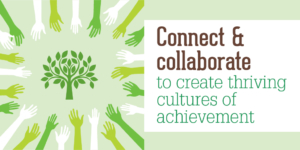As I tested the audio and prepared for my presentation — tucked away in the back of a large lecture hall — I didn’t realize that attendees had packed the room. By 10:00 a.m. central time, educators and their industry partners filled the round tables and lined themselves politely along the walls. The scene: ACTE’s CareerTech VISION 2021 in New Orleans, Louisiana. And my session topic? Professional learning communities (PLC) in career and technical education (CTE).

We discussed how to create thriving cultures of achievement within CTE.
And we had so much fun! For 25 minutes, I described the research and results of PLC implementation from my own experiences and then engaged with the dozens of other CTE experts in the room in a riveting session of question-and-answer. The questions were challenging and thought provoking. Often, I saw nods of agreement cross the room. Because we all face similar persistent problems, and we can easily identify with one another. This is symbolic of what makes VISION so extraordinary.
CTE stakeholders attend ACTE’s CareerTech VISION because they know that they will engage in meaningful conversation. I know because it is why I personally attend VISION whenever the opportunity arises.
Connect and collaborate
Collaboration and talking with others about best practices and new strategies fuels everyone forward. As a result, I am driven by opportunities to contribute and learn from the contributions of others. One such opportunity to contribute presented itself in fall 2020. ACTE sent out a call for CTE professionals interested in joining a pilot group of mentors for the Inclusion, Access, Equity and Diversity (IAED) Mentorship Program. I applied and was accepted. Then, a few months later, I found myself matched with a mentee from Wisconsin: Jim Michlig.
Jim and I had our first chat conversation, and we marveled over how our school and community demographics were different in nearly all respects. Nevertheless, Jim and I committed to meet monthly to discuss equity and the various challenges involved with improving access to high-quality CTE for all students. We wrestled with how to develop understanding about the opportunities. And we both wanted to provide more support for students with disabilities to succeed in our programs. And we both wanted to bring more female students into traditionally male-dominated CTE fields of study — like welding — and more male students into pathways like nursing. Over the course of the year, Jim and I shared our best practices and bounced ideas off of one other. Before long, you never could have guessed who the mentee or mentor among us was.
The epiphany
Back on site in New Orleans, I’d only just begun my session when I realized that Jim Michlig sat in the audience. A big smile crept across my face. Then, later, as the session closed, Jim and I met. We were so excited, finally, to talk in person that we felt that the moment had to be captured with a photo. So, randomly, I tapped the shoulder of a gentleman to ask if he would take our photo. As he turned, graciously accepting the offer, I realized it was Kevin J. Fleming, an educator, CEO and previous VISION keynote speaker. He was ecstatic that we recognized him! And we all had a big laugh about the coincidence of the chance meeting.
Realizing that we all had places to go, we exchanged business cards and parted ways. Within minutes, I ran into Mark Perna on the escalator, and I remarked that I had been inspired to make changes after hearing him speak at VISION a few years before. I described how his work improved our work. And then we said goodbye. I reflected on the conversations that I had just had — conversations made possible by my attendance at several ACTE events over the years.
Stand on the shoulders of giants.
CTE instructors and administrators strive to be leaders who cast a legacy marked by these descriptors. We know our why. We’re in the business of shaping the next generation of workforce leaders. And we support each other to better support our students. The question we wrestle with is rather how. How do I find out what is propelling student achievement in other CTE programs? How can I learn about innovative practices that increase access to high-quality CTE for diverse student groups?
When you cannot cast your own vision, you stand on the shoulders of giants. In a famed letter from mathematician, astronomer and physicist, Sir Isaac Newton credited the work of his predecessors for furthering his own discoveries. He knew that without their research, and seeing where they had succeeded and failed, his work would have faltered. I couldn’t imagine the breadth of valuable resources I would collect at VISION and through ACTE. In the few short months since I left New Orleans, already, I have made connections between my colleagues and presenters and their data they so willingly shared.
Overall, the lesson in this is simple: When you look beyond your own world view and take in different perspectives, you can see farther. And you begin to see possibilities that were previously hidden from view.

Conclusion
Career and technical educators have the power to help students see new possibilities for themselves by creating workforce opportunities. Every year that we attend an event like VISION or join an ACTE program, we provide opportunities for our students. Students need us to learn from others. Students need us to improve our practices to provide the educational experience they deserve.
They need us to acknowledge — and work to disrupt — the very real challenges they face to success in high-wage, high-demand CTE fields of study. The more we can identify these truths, and check in, and create opportunities for high-quality, work-based learning opportunities, the better we will succeed in plant.ing the seeds of possibility thinking.
Sandra Adams, Ph.D., challenges fellow educators to reimagine the future of CTE teaching and learning. Her decades-long career in education includes work as a teacher, administrator and instructional coach. Adams currently works as an administrator with the FWCS Career Academy and continues to consult with CTE schools across the country. Email her.






